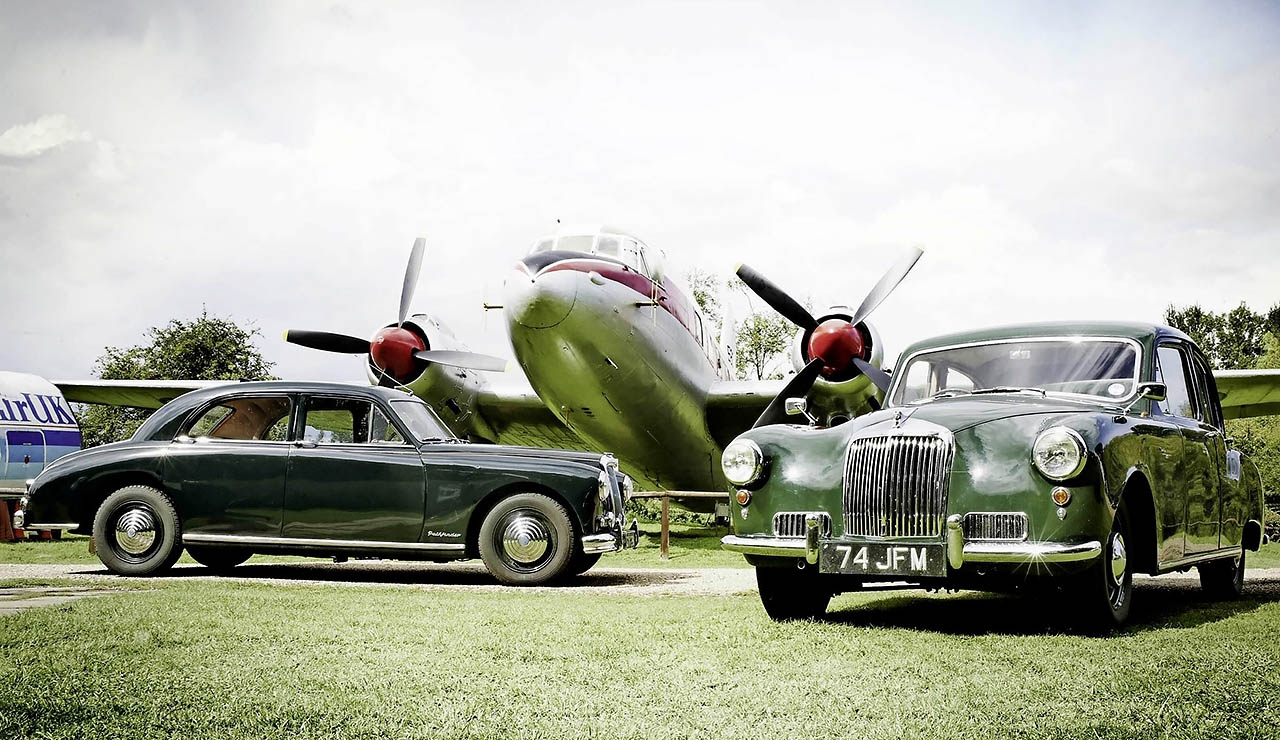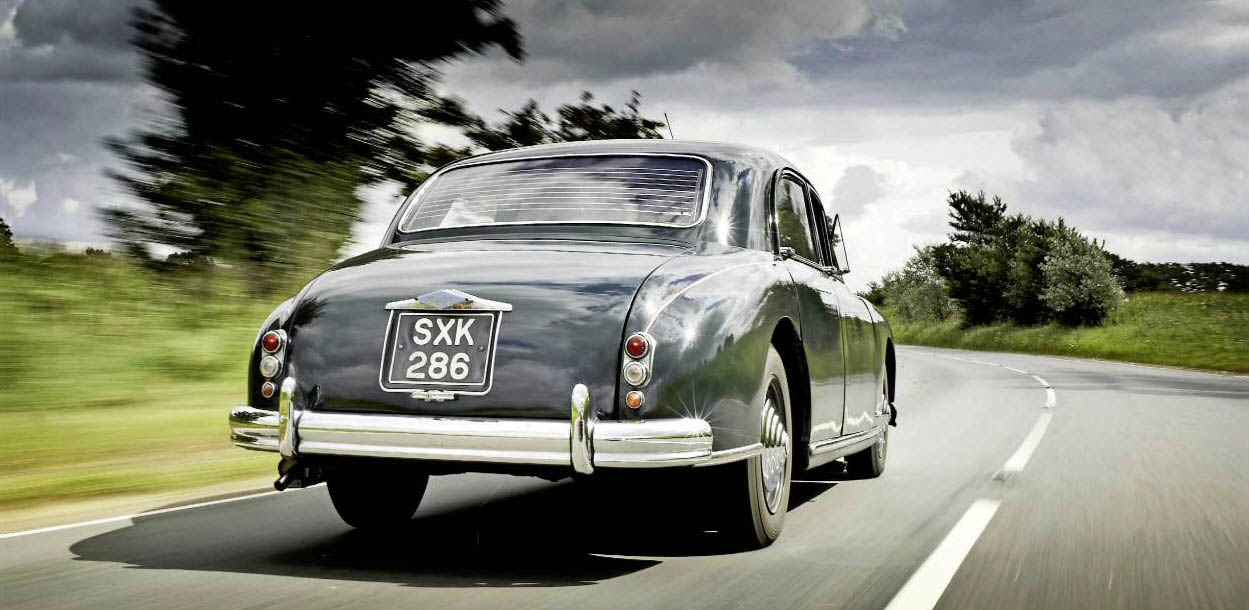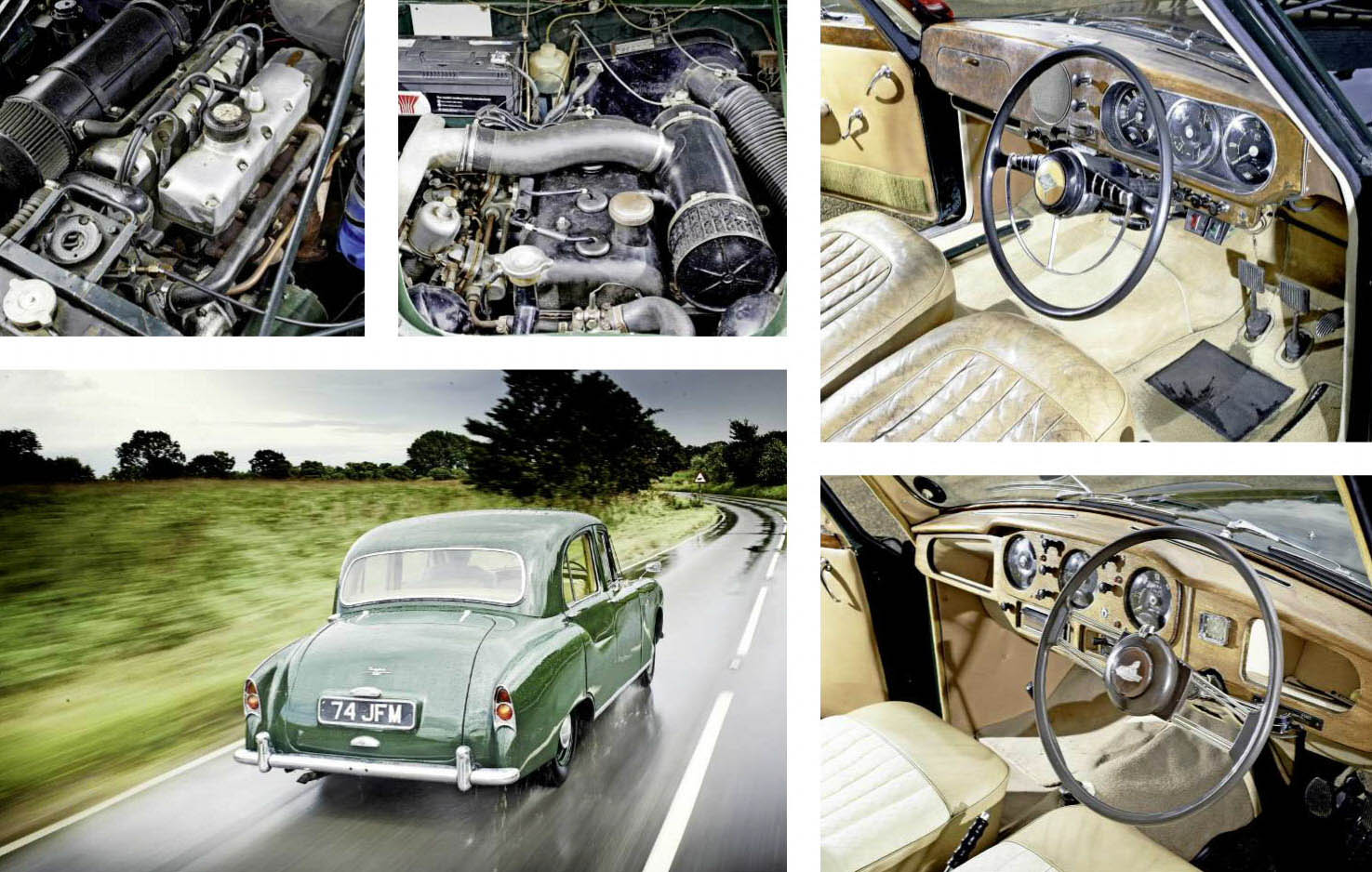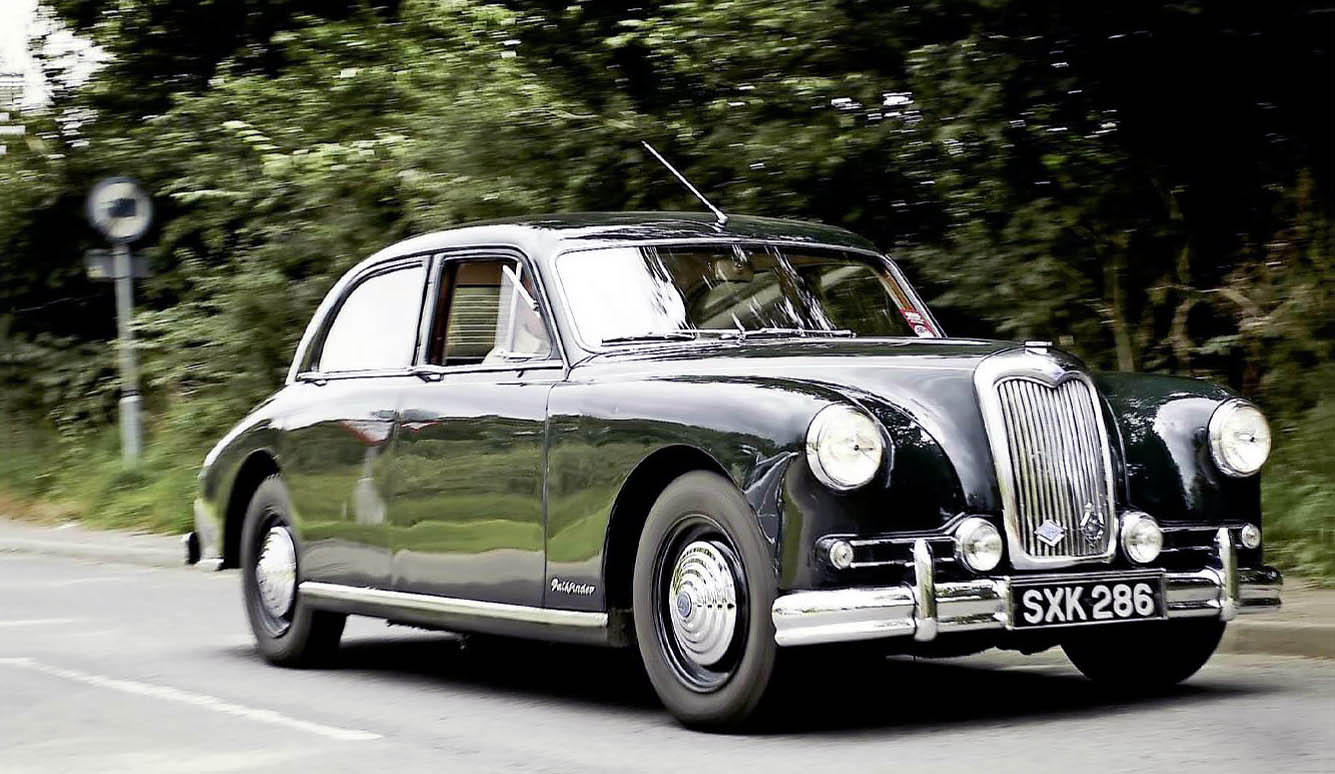
Fit For A Gentleman. Fifties tourers Two stalwarts of a dying breed – the Riley Pathfinder and Armstrong Siddeley Sapphire – endured during the late-Fifties. Which is the preferred gentleman’s carriage? The Riley Pathfinder and Armstrong Siddeley Sapphire 234 were both aimed at well-heeled men who wished to drive while wearing the correct hat, but went about it in very different ways. Words Andrew Roberts. Photography Gus Gregory.
As the upper-middle-class touring car edged towards a comfortable retirement in the mid-Fifties, two marques continued to produce such conveyances, making bold attempts to appeal to slightly newer money without offending their traditional customer bases. The Riley Pathfinder and the Armstrong Siddeley Sapphire 234 were both expensive, costing well over £1000, and both were powered by big four-cylinder engines. They also have equal top speeds, but it’s the manner in which they get to the ton that sets them apart. You can imagine a Pathfinder owner attempting to overtake a Ford Zephyr-Zodiac with the sotto voce remark of ‘spiv’, but the more sprightly Armstrong Siddeley would simply dart right past it.
Pressing the starter button provokes the Home Service sound of the Pathfinder’s twin-cam, whose blend of smoothness and torque was never quite equalled in the minds of many Riley enthusiasts. For a powerplant with only four cylinders, it sounds utterly refined and the discreet note provides a definite link with previous Rileys – but here comparisons with older models cease. Any motorist who was used to the RM’s split windshield, ornate gold-on-white dials and narrow scuttle would have found the Pathfinder extremely contemporary, with enough headroom for five or six occupants to comfortably wear Homburg hats.
In 1956 a gentleman of sporting inclinations might have well sought out the new Armstrong Siddeley. If the Riley Pathfinder is a near definitive Fifties headmaster’s car, the 234 is the ideal transport for a BEA captain just home from piloting a Vickers Viscount from Rome. The Armstrong is not so much a grand tourer as a four-door sports car – indeed, wire wheels were an optional extra – and one which illustrates how ambitious the company still was, even in the twilight of its car production.
Riley’s advertising claimed that in the Pathfinder you would be aware of ‘remarkable roadholding qualities; stability with surging power. Fast cruising in luxurious comfort; fast cornering in perfect safety’. But although it is far from unpleasant to drive, this is no sports saloon. One reason is that Riley dispensed with rack-and- pinion steering in favour of a low-geared worm-and- roller system that is heavy even by Fifties standards and requires a great deal of turning at low speeds to change direction to the mildest degree. The potential for brisk performance is also limited by the gearlever, situated on the floor to the right of the driver. As a whole, the box feels more precise than many three- or four-speed column shifts of that era, but rapid upward shifts into second are still occasionally awkward.
Perhaps the real forté of the Riley Pathfinder as a five/six-seater saloon of quality and dignity is the comfortable transportation of dignitaries along the trunk roads of pre-motorway Britain. The overdrive, as our test car’s proud owner Mike Laflin notes, ‘has a nice feel to it, like the kickdown for an automatic box’.
It is no insult to say that I find the overall sensation of Pathfinder motoring akin to driving a Wolseley of the same era. There is no C-series transmission whine, so familiar from countless low-budget British crime films, but the Pathfinder seems closer to a 6/90 than to previous Rileys – and in the early Fifties this was one of its principal marketing challenges. The Pathfinder may have been one of the first new cars to emerge after the British Motor Corporation was formed from the Austin-Nuffield merger, but its origins date back to 1949 when Gerald Palmer was tasked with planning an integrated model line-up that would replace the MG Y saloon, the Wolseley 4/50 and 6/80 plus the Riley RM. Badge engineering was established practice for Morris, MG and Wolseley products, but prior to the Pathfinder’s 1953 launch it had never occurred with a Riley.
In 1954 the Wolseley 6/90 was launched, combining a modified version of the Pathfinder’s body with a BMC C-series 2.6-litre engine. Although in certain quarters the marque was tarnished by association with lesser Nuffield products, Riley definitely ranked above Wolseley in the great British social hierarchy – the latter was all suburban tennis club whereas the former was quietly aristocratic – and the co-development of the Pathfinder and 6/90 allowed certain economies of scale.
Rack-and-pinion steering was not available because there was no space for it below the Wolseley’s engine. More controversially, both cars had a rear suspension that was plagued with issues, not least one of Panhard rods leaving their mountings. Our test car is one of the last coil sprung models prior to BMC adopting a simpler leaf-spring system in 1956.
In contrast, the Armstrong Siddeley has light, accurate steering and a short, stubby gearlever – mercifully centrally mounted – that can easily glide through the all-synchromesh gearbox. The sensation of lightness is accentuated by power-assisted brakes that bring the 234 to a halt with an ease that would befit a car costing twice as much.
Aesthetics are personal matters, but to my eyes the 234 lacks the balance of the Riley – the central hull seems totally at odds with its nose and tail. The Armstrong conveys little of the Pathfinder’s slightly formidable air. When viewed directly head on, the 234’s low bonnet line is quite impressive, but the vestigial tail fins look incongruous and the cabin gives the sense that Armstrong Siddeley partially took stylistic inspiration from a Morris Oxford Series 3.
My first impression of our Riley test car was simply that it is an incredibly handsome car. The Pathfinder certainly had the elegance to be a fashionable town car ‘The Pathfinder’s forté is the comfortable transportation of dignitaries along trunk roads’ and Lionel Bart was one early celebrity owner. Palmer’s coachwork for the smaller Z-series MG Magnette is justly lauded, but to me the Riley is equally elegant, if bigger. Period photographs featuring dashing chaps with caps at a jaunty angle don’t really convey the sheer size of the Pathfinder but it doesn’t appear at all bulky in the manner of a Humber Super Snipe or an Austin Sheerline. When Palmer created the RM 2.5-litre’s successor he was inspired by the Lancia Aurelia, and the result is a British car that lacks extraneous chrome.
The Riley interior continues the theme of good taste on a fairly lavish scale, with comprehensive instrumentation arranged in a rather more ergonomic manner than on a Jaguar MkVII – an adjustable steering column is one of a number of thoughtful details. But one archaic touch was that right-hand gearchange. A few British cars such as the Bentley R-type persisted with this device into the Fifties, but although the Riley’s is situated in a cutaway in the front seat there remains the persistent fear that one will dislodge the lever when entering the Pathfinder.
To a 1956-vintage driver, the 234’s Sphinx bonnet mascot and radiator grille may have been familiar, as was the Sapphire prefix, but inside there is little sense of overt traditionalism. Compared with the Pathfinder the cabin appears on the cusp between businesslike and austere with its nylon/PVC trim, plain door trims and open gloveboxes. Such restraint gives the Armstrong a purposeful air with a tachometer among the dials and a switch for the Laycock-de-Normanville overdrive on the right of the steering column.
George Coutts’ car is now so rare – survivors of the 234 model are believed to be in single figures – that it is a genuine surprise how substantial the ‘baby Sapphire’ looks. Not that it drives like a standard large Fifties British saloon, for the Armstrong neither wallows on narrow rural lanes nor lumbers through built-up areas.
On A-roads the 234 is completely stable with an aura of quiet confidence. Its appearance and performance are totally at odds with each other; its looks were faintly dated, even six decades ago, but the dynamics make the Armstrong seem 15 years younger than its actual age.
The 234 had followed on from Armstrong Siddeley’s first smaller model, the six-cylinder 236, launched in 1955 – a car intended to appeal to a young go-ahead chap of means. Under the bonnet was a modified version of the 1949 Whitley’s engine offering performance best described as stately. So in 1956 the firm launched the 234, powered by a twin-carburettor 2.3-litre unit giving 35bhp more than the 236, all for a price saving of £28 10s. There was even a rev counter to denote the new version’s high-performance status. A mere 803 were sold between 1956 and 1958, but had the 234 appeared in 1955 rather than the 236, and had its roofline been a mere two inches lower, Armstrong Siddeley Motors could have severely dented sales of the MkVII Jaguar 3.4. In fact, the domed roof line was a result of the director Cyril Siddeley’s requirement for a car that would enable the occupants to wear formal headgear, reflecting the fact that it was the product of a firm where, ‘The top hat is always smarter than the bowler’.With the Riley, a driver tends to adopt a formal posture at the wheel, but in the 234 I am comfortably accommodated in a bucket seat where there is certainly space enough for me to don a top hat. Both of these cars were the products of marques approaching the end of their lives. Armstrong Siddeley’s car operations were too small at a time when its aviation projects demanded sizeable development budgets. In summer 1960 it ceased car production.
As for the Riley, the last Pathfinders left the showrooms in 1957, signalling the end of the first true badge-engineered car to bear the famous diamond logo. The marque disappeared in 1969, after many years of British Motor Corporation neglect. Had Palmer been allowed to develop the Pathfinder, automotive history might have been different. So, although the 234 is a sporting saloon of great distinction, the Riley is the car I’d rather take home – in part because I have a weakness for the underdogs of the motoring world but mainly for its perfect late-period Ealing Studios appeal.
TECHNICAL DATA FIFTIES TOURERS RILEY PATHFINDER vs. ARMSTRONG SIDDELEY SAPPHIRE 234
1956-1958 Armstrong Siddeley Sapphire 234
Engine 2290cc, four-cylinder ohv, twin SU carburettors
Power and torque 120bhp @ 5000rpm; 139lb ft @ 3500rpm
Transmission Four-speed manual
Steering Burman recirculating ball
Suspension
Front: independent coil springs.
Rear: live axle, semi-elliptic springs
Brakes Drums front and rear
Weight 1360kg
Performance
Top speed: 100mph;
0-60mph: 12.3sec
Fuel consumption 17mpg
Cost new £1411 7s
Values now £4000-£11,500
1953-1957 Riley Pathfinder
Engine 2443cc four-cylinder twincam, twin SU carburettors
Power and torque 110bhp @ 4400rpm; 134lb ft @ 3000rpm
Transmission Four-speed manual overdrive
Steering Worm and roller
Suspension
Front: independent, wishbones, torsion bars
Rear: live axle, semi-elliptic springs
Brakes Drums front and rear
Weight 1549kg
Performance
Top speed: 100mph
0-60mph: 17.5sec
Fuel consumption 20mpg
Cost new £1238 14s 2d
Values now £2250-£8000

The Riley would have commanded respect rather than excitement on Fifties roads.

Riley’s right-hand gearchange lies in wait for your trouser leg. Armstrong Siddeley will spin its speedo faster than the Riley. What? No hat? This would be unthinkable when these cars were new.

Riley’s twin-cam 2.4 four-cylinder is smooth, torquey and refined. Armstrong’s roofline is great for hat-wearers, less so for aesthetes. The 234’s 2.3-litre four is a peppier motor with better acceleration. Riley has adjustable steering column but right-hand gearchange. Less lavish 234 cockpit has PVC trim and open gloveboxes.

Pathfinder is like an over-inflated MG Magnette.
WHAT THEY’RE LIKE TO OWN
George Coutts has owned his Armstrong Siddeley Sapphire 234 ‘since 1968 – and it was pretty rare even then. It feels quite fast once it’s wound up and it keeps up easily with modern traffic.’ Over the years, George has fitted a new camshaft and a rear axle, and the cooling system was a challenge.
A second 234 served as a donor car, ‘Over the last 40-odd years I’ve had few problems with spares although luckily I have needed few bodywork parts. Of course, the club is also very good in that regard.When I bought it, steel parts were riddled with corrosion.’
With the aid of a local metal worker George had to fashion replacement panels and although the doors are aluminium he found the door surrounds to be particularly vulnerable.
As for those distinctive 234 lines, ‘The story is that Cyril Siddeley had his hat knocked off when he got into a prototype and immediately ordered the roof to be raised by two inches!’
Mike Laflin is a car enthusiast of many years standing and among other vehicles he has owned, such as a Lotus Cortina MkII and MG Magnette MkIV Farina, he regards his Pathfinder as ‘so comfortable, and such a smooth and pleasant vehicle to drive.’ It’s Mike’s second Pathfinder. ‘I bought my first in 1989 and I’ve owned this one since 2001.
‘When I got it home, I found no oil pressure at all; the filter in the sump was blocked. Apart from that, I found the Riley to be quite reliable and I do like to use her a lot’.
In Mike’s experience the Riley Motor Club is very helpful when it comes to making spare parts. ‘Original spares are very hard to come by – the early gearboxes particularly.’ Regarding rust, Mike found the sills and front valance especially vulnerable.
‘It feels splendid when I take it out and get it into overdrive-top,’ he says, ‘but I’m almost inevitably approached by someone wanting to know if it’s an old police car.’
{CONTENTPOLL [“id”: 61]}





